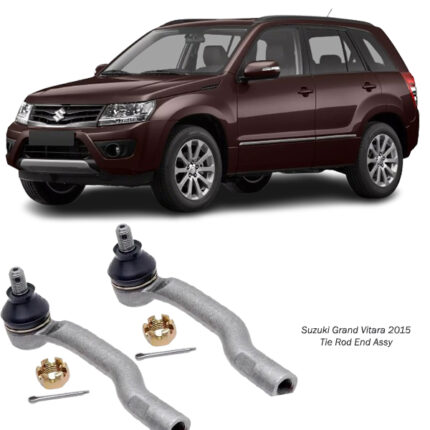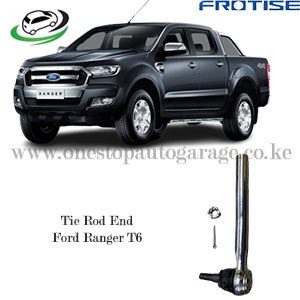-17%
Get Tie Rod End Sub Assy Toyota Wish 45047-49045
The tie rod end assembly is a crucial component of a vehicle’s steering system. It serves as a pivotal link between the steering rack and the steering knuckle, enabling the wheels to turn and the vehicle to maneuver. This component’s functionality and reliability are essential for safe and responsive driving. Understanding the tie rod end assembly involves delving into its components, operation, common issues, and maintenance practices.
Components of the Tie Rod End Assembly
- Inner Tie Rod: Connected to the steering rack, the inner tie rod transmits the steering force from the steering wheel to the outer tie rod.
- Outer Tie Rod: Attached to the steering knuckle, the outer tie rod translates the movement from the inner tie rod to the wheels.
- Tie Rod End: This is a ball-and-socket joint that connects the tie rod to the steering knuckle, allowing for pivoting movement necessary for steering.
- Adjusting Sleeve: This component links the inner and outer tie rods and allows for the adjustment of the vehicle’s alignment.
Benefits of Tie Rod Ends;
1. Enhanced Steering Precision and Control
Tie rod ends are vital for transmitting the force from the steering wheel to the wheels, allowing for precise control over the direction of the vehicle. This direct connection ensures that the driver’s inputs are accurately reflected in the movement of the wheels, providing responsive and predictable steering behavior.
2. Improved Vehicle Safety
Safety is paramount in vehicle design, and tie rod ends contribute significantly to this aspect. By ensuring that the wheels turn accurately according to the steering inputs, tie rod ends help maintain control of the vehicle under various driving conditions. Worn or damaged tie rod ends can lead to misalignment and steering issues, which can increase the risk of accidents.
3. Enhanced Driving Comfort
Smooth and efficient steering is essential for a comfortable driving experience. Tie rod ends facilitate this by reducing the effort required to turn the steering wheel and by minimizing vibrations transmitted from the road to the steering wheel. This results in a smoother, more comfortable ride for the driver and passengers.
4. Even Tire Wear
Properly functioning tie rod ends ensure that the wheels are correctly aligned, which is crucial for even tire wear. Misalignment caused by worn or damaged tie rod ends can lead to uneven tire wear, reducing the lifespan of the tires and potentially causing other handling issues. Regular maintenance of tie rod ends helps in maximizing tire life and reducing replacement costs.
5. Optimized Fuel Efficiency
When the wheels are properly aligned, the vehicle experiences less rolling resistance, which can improve fuel efficiency. Misalignment due to faulty tie rod ends can cause the vehicle to use more fuel as it struggles to maintain a straight path. By keeping the tie rod ends in good condition, drivers can potentially save on fuel costs over the long term.
6. Reduced Wear on Suspension Components
Tie rod ends play a role in reducing the strain on other suspension components. When tie rod ends are in good condition, they help maintain proper alignment and balance, reducing the wear and tear on parts such as ball joints, control arms, and bushings. This can extend the overall lifespan of the suspension system and reduce maintenance costs.
7. Maintaining Proper Wheel Alignment
Proper wheel alignment is crucial for vehicle stability and handling. Tie rod ends are adjustable, allowing for precise alignment of the wheels. This ensures that the vehicle tracks straight and does not pull to one side, enhancing stability and control, especially at higher speeds.
8. Minimizing Steering Wheel Play
Excessive play in the steering wheel can be a sign of worn tie rod ends. This can make the vehicle feel unresponsive and difficult to control. Replacing worn tie rod ends can restore the tightness and responsiveness of the steering system, making the vehicle more enjoyable and safer to drive.
9. Supporting Advanced Driver Assistance Systems (ADAS)
Modern vehicles equipped with Advanced Driver Assistance Systems (ADAS), such as lane-keeping assist and autonomous emergency braking, rely on precise steering inputs to function correctly. Well-maintained tie rod ends ensure that these systems can operate as intended, providing additional layers of safety and convenience to the driver.
10. Cost-Effective Maintenance
Tie rod ends are relatively inexpensive compared to other steering and suspension components. Regular inspection and timely replacement of tie rod ends can prevent more costly repairs down the line. By addressing issues early, drivers can avoid more extensive damage to the steering and suspension systems.
Common Issues with Tie Rod Ends
- Wear and Tear: Over time, the ball-and-socket joint can wear out due to constant movement and load, leading to loose steering and alignment issues.
- Corrosion: Exposure to elements can cause rust and corrosion, weakening the tie rod ends and potentially leading to failure.
- Impact Damage: Hitting potholes or curbs can bend or break tie rod ends, severely affecting the vehicle’s steering capability.
Symptoms of Failing Tie Rod Ends
1. Uneven Tire Wear
Description:
- Uneven tire wear is one of the most common signs of failing tie rod ends. When tie rod ends wear out, they can cause misalignment of the wheels, leading to uneven distribution of weight and pressure on the tires.
Indicators:
- You may notice one side of the tire is more worn than the other.
- Feathering or scalloping on the edges of the tires.
Why it Happens:
- As tie rod ends deteriorate, they lose their ability to maintain proper wheel alignment. This misalignment causes parts of the tire to wear out faster than others, reducing the overall lifespan of the tire.
2. Steering Wheel Vibration
Description:
- A vibrating steering wheel is another indicator of potential tie rod end issues. The vibration can be felt especially at higher speeds and is often more pronounced when the vehicle is turning or cornering.
Indicators:
- Noticeable vibration or shaking of the steering wheel while driving.
- The intensity of vibration may increase with speed or during turns.
Why it Happens:
- Loose or worn tie rod ends cause the wheels to wobble slightly, which translates into vibrations felt through the steering wheel. This instability is often more apparent when the vehicle is moving at higher speeds.
3. Clunking Noise
Description:
- A clunking or knocking noise when turning the steering wheel is a strong indication of worn tie rod ends. This noise is typically caused by the ball-and-socket joint becoming loose or worn out.
Indicators:
- Audible clunking or knocking sounds when turning the steering wheel.
- The noise may be more noticeable during sharp turns or when driving over bumps.
Why it Happens:
- As tie rod ends wear, the internal components can develop play. This looseness results in the metal parts clunking against each other, producing a distinct noise during steering movements.
4. Loose Steering
Description:
- Loose or imprecise steering is a symptom of failing tie rod ends. Drivers may notice increased play in the steering wheel, requiring more effort to keep the vehicle straight or to navigate turns.
Indicators:
- Excessive play or “free play” in the steering wheel.
- Difficulty maintaining a straight line while driving.
- Steering feels less responsive and more “sloppy.”
Why it Happens:
- Tie rod ends are responsible for translating the movement of the steering wheel into the turning of the wheels. When they become worn, this connection becomes less precise, leading to a loose or wandering steering feel.
5. Vehicle Pulling to One Side
Description:
- A vehicle that pulls to one side, especially when driving on a straight, flat road, can indicate a problem with the tie rod ends. This symptom is often mistaken for alignment issues but can be directly related to the condition of the tie rod ends.
Indicators:
- The vehicle drifts or pulls to one side without steering input.
- Constantly needing to correct the steering to keep the vehicle straight.
Why it Happens:
- Uneven wear or failure of tie rod ends can cause one wheel to be misaligned relative to the other. This misalignment results in the vehicle pulling to the side with the faulty tie rod end.
6. Unstable Steering and Poor Handling
Description:
- Unstable steering and poor handling characteristics can be attributed to failing tie rod ends. This includes difficulty controlling the vehicle, especially during turns or at higher speeds.
Indicators:
- Steering feels unpredictable or erratic.
- The vehicle feels unstable or “floaty” when driving.
Why it Happens:
- Worn tie rod ends compromise the stability and precision of the steering system. This can make the vehicle feel unstable and difficult to handle, reducing driver confidence and overall safety.
Replacement Process
- Preparation: Lift the vehicle and secure it with jack stands. Remove the front wheels to access the tie rod ends.
- Loosening the Nuts: Loosen the jam nut on the adjusting sleeve and the nut securing the tie rod end to the steering knuckle.
- Removing the Tie Rod End: Use a tie rod puller or a hammer to separate the tie rod end from the steering knuckle. Unscrew the tie rod end from the adjusting sleeve.
- Installing the New Tie Rod End: Screw the new tie rod end into the adjusting sleeve, ensuring it matches the position of the old one to maintain alignment.
- Reassembly: Reattach the tie rod end to the steering knuckle and tighten the nuts. Reinstall the wheels and lower the vehicle.
- Alignment: Perform a wheel alignment to ensure the vehicle handles correctly and the tires wear evenly.
Follow us on Facebook for more parts.



